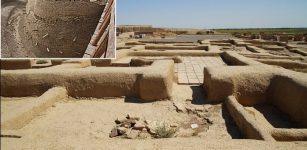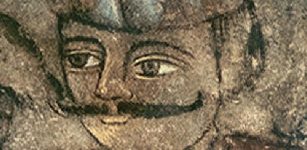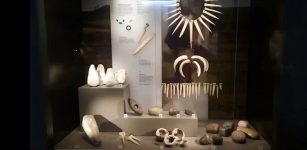3,000-Year-Old History Of Tea: World’s Second Most-Consumed Drink After Clean Water
A. Sutherland - AncientPages.com - According to the opinion of the majority of experts on the subject, the homeland of tea is China.
![A painting of ancient Chinese playing a competitive game based on tea drinking in the Song Dynasty (960-1279). [Photo/people.cn]](https://www.ancientpages.com/wp-content/uploads/2019/04/teachinatradition1.jpg) A painting of ancient Chinese playing a competitive game based on tea drinking in the Song Dynasty (960-1279). Image credit: people.cn
A painting of ancient Chinese playing a competitive game based on tea drinking in the Song Dynasty (960-1279). Image credit: people.cn
Already three thousand years ago, and perhaps much earlier, the local population used tea leaves to prepare a medicament to alleviate stomach problems and increase concentration.
The habit of drinking tea for pleasure has been developing very slowly over many centuries.
According to legend, it all started in China around 2737 BC. One day, the Chinese emperor – Shennong (Shen Nung), an herbalist and scholar who usually drank only boiled water, rested under a wild tea tree.
Suddenly, a rush of wind caused several leaves to fall from the tree into his pitcher with water. Later, after taking the drink into his mouth, he felt an entirely new taste that surprised and charmed him.
Iranians usually drink tea with rock candy and in glass cups. Image credit: Persian Food Tours - CC BY-SA 4.0 DEED
The Chinese kept their secret for a long time. The first written mention of this plant dates back to the third century BC, and for many years, tea, made from the leaves of wild tea trees, was used only as a medicine and strengthening agent.
Hot tea promoters were Buddhist monks who discovered that tea helped them much during long hours of meditation. By the second century BC, Buddhist monks had found tea' to have stimulating properties and contributed to its cultivation and development.
During the Tang Dynasty (618-907), monks from Korea and Japan started to visit Buddhist monasteries in China more and more often. Returning to their homelands after many years of study, the monks took with them seeds of plants to undertake the first attempts to grow a tea bush in the secluded gardens.
They also introduced the custom of drinking tea to the religious ceremony. In the twelfth century, in Japan, there was a ritual in honor of the Buddha and the legendary founder of the Zen sect, Bodhidharma, known in Japan as Daruma.
Azerbaijani tea culture. Image credit: Investigation11111 - CC BY-SA 4.0 DEED
A few centuries later, tea became a popular and widely available drink. The art of preparing and drinking tea became a popular ritual, and teahouses began to appear.
In the mid-8th century, tea drinking became widely popular during the Tang Dynasty, and around 803 AD, monk Dengyo Daishi took the first seeds of a tea plant to Japan.
Soon, the reputation of this prestigious beverage drink spread to Korea, Japan, Vietnam, and Tibet. Through the centuries, various techniques for drying and processing tea and several different forms of tea were developed.
Europeans had already heard about tea from missionaries returning from the Far East. However, the Dutch were the first to bring it to Europe. The Dutch company East India Co. imported the prestigious tea beverage from China to Europe in 1609.
The ceremony of drinking tea as a new exotic drink spread in England, where it came to Thomas Garraway, a merchant and a shop owner in London). Initially, the privilege of consuming this exotic drink was only limited to very wealthy people - the royal family and aristocracy.
A few decades later, a marvelous tea beverage reached the rest of Europe, and elegant, beautifully decorated accessories and the opening of tearooms appeared across the continent.
At the same time, tea by land was brought to Russia as a gift from the Emperor of China for Tsar Nicholas Romanov.
Image credit: Samovary.ru
The Russian 'Samovar '("samovar" is "self-boiling") is the Russian tea machine, considered to be much better than other water-heating devices. In early times, the samovar was used not only for boiling water but also for boiling soup and 'sbiten' (hot honey & spice hot winter beverage. )
Soon, it appeared not only among the magnates; at the end of the 18th century, despite the still relatively high price, tea began to welcome guests at the tables of less affluent people.
Camel caravans packed with boxes filled with tea roamed the mountain regions, deserts, and steppes of Central Asia, southern Siberia, and Russia until the early twentieth century. Then, the situation changed for tea transport when the Trans-Siberian Railway was completed, and trade between China and Russia was revolutionized.
Written by – A. Sutherland - AncientPages.com Senior Staff Writer
Updated on Nov 18, 2023
Copyright © AncientPages.com All rights reserved. This material may not be published, broadcast, rewritten or redistributed in whole or part without the express written permission of AncientPages.com
More From Ancient Pages
-
 Stunning Ancient Roman Artifacts And Three Shipwrecks Discovered Underwater Off The Coast Off Alexandria, Egypt
Archaeology | Nov 26, 2017
Stunning Ancient Roman Artifacts And Three Shipwrecks Discovered Underwater Off The Coast Off Alexandria, Egypt
Archaeology | Nov 26, 2017 -
 2,000-Year-Old Instruments Used By Roman Surgeons Revealed By Archaeological Scanners
Archaeology | Jul 17, 2024
2,000-Year-Old Instruments Used By Roman Surgeons Revealed By Archaeological Scanners
Archaeology | Jul 17, 2024 -
 Climate Change, Not Genghis Khan Caused Demise Of Central Asia’s River Civilizations
Archaeology | Dec 17, 2020
Climate Change, Not Genghis Khan Caused Demise Of Central Asia’s River Civilizations
Archaeology | Dec 17, 2020 -
 On This Day In History: Vlad II Known As Vlad Dracul (‘Vlad The Dragon’) Was Born – On August 30, 1400
News | Aug 30, 2016
On This Day In History: Vlad II Known As Vlad Dracul (‘Vlad The Dragon’) Was Born – On August 30, 1400
News | Aug 30, 2016 -
 Two Well-Preserved Shipwrecks Found By Swedish Maritime Divers In Baltic Sea
Archaeology | Jan 30, 2018
Two Well-Preserved Shipwrecks Found By Swedish Maritime Divers In Baltic Sea
Archaeology | Jan 30, 2018 -
 Mysterious Jawbone May Represent Earliest Presence Of Humans In Europe
Archaeology | Dec 7, 2022
Mysterious Jawbone May Represent Earliest Presence Of Humans In Europe
Archaeology | Dec 7, 2022 -
 What Was Legio Martia And Why Were The Roman Soldiers Called The Martians?
Ancient History Facts | Jan 5, 2018
What Was Legio Martia And Why Were The Roman Soldiers Called The Martians?
Ancient History Facts | Jan 5, 2018 -
 Thousand year old Pagan warrior tomb discovered in Poland
News | Aug 23, 2015
Thousand year old Pagan warrior tomb discovered in Poland
News | Aug 23, 2015 -
 Mystery Of The Giant Hand At The Temple Of Hercules
Featured Stories | Jul 17, 2019
Mystery Of The Giant Hand At The Temple Of Hercules
Featured Stories | Jul 17, 2019 -
 Evidence Europeans Made Leather Clothing 40,000 Years Ago – New Study
Archaeology | Apr 17, 2023
Evidence Europeans Made Leather Clothing 40,000 Years Ago – New Study
Archaeology | Apr 17, 2023 -
 Underwater Ancient Cypress Forest Offers Clues To The Past
Archaeology | Jun 29, 2021
Underwater Ancient Cypress Forest Offers Clues To The Past
Archaeology | Jun 29, 2021 -
 Oldest Known Evidence Of Artificial Cranial Deformation Revealed In Croatia
Archaeology | Aug 26, 2019
Oldest Known Evidence Of Artificial Cranial Deformation Revealed In Croatia
Archaeology | Aug 26, 2019 -
 Horses Skinfaxi And Hrimfaxi – Bringers Of Light And Darkness To Earth In Norse Mythology
Featured Stories | Dec 16, 2017
Horses Skinfaxi And Hrimfaxi – Bringers Of Light And Darkness To Earth In Norse Mythology
Featured Stories | Dec 16, 2017 -
 Ancient Goldsmith’s Toolkit Discovered Near Stonehenge
Archaeology | Dec 16, 2022
Ancient Goldsmith’s Toolkit Discovered Near Stonehenge
Archaeology | Dec 16, 2022 -
 Cuneiform Tablet Unearthed In Hittite City Samuha Refers To Love And War Goddess Sausga
Archaeology | Oct 2, 2023
Cuneiform Tablet Unearthed In Hittite City Samuha Refers To Love And War Goddess Sausga
Archaeology | Oct 2, 2023 -
 Roman-era mass grave with 60 bodies found in farmer’s field
Civilizations | Aug 27, 2015
Roman-era mass grave with 60 bodies found in farmer’s field
Civilizations | Aug 27, 2015 -
 On This Day In History: First European Sights The Ruins Of Ancient Maya City Of Copán – On Mar 8, 1576
News | Mar 8, 2017
On This Day In History: First European Sights The Ruins Of Ancient Maya City Of Copán – On Mar 8, 1576
News | Mar 8, 2017 -
 1.5-Million-Year-Old Footprints Of Two Different Species Of Human Ancestors Found At The Same Spot
Human Beginnings | Nov 29, 2024
1.5-Million-Year-Old Footprints Of Two Different Species Of Human Ancestors Found At The Same Spot
Human Beginnings | Nov 29, 2024 -
 How Did Sea Level Rise Impact Human Groups During Mesolithic And Neolithic Periods?
Archaeology | May 20, 2022
How Did Sea Level Rise Impact Human Groups During Mesolithic And Neolithic Periods?
Archaeology | May 20, 2022 -
 What Rights Did Viking Women Have?
Ancient History Facts | Mar 19, 2021
What Rights Did Viking Women Have?
Ancient History Facts | Mar 19, 2021



